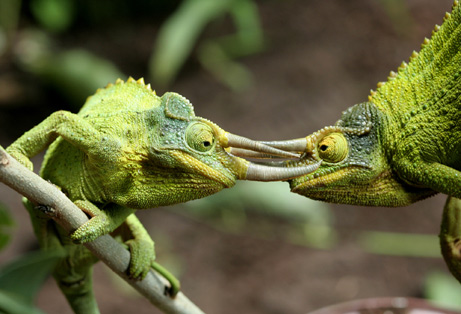The chameleon is a reptile known for its sophisticated camouflage by changing color.
Chameleons are reptiles known for their sophisticated camouflage by changing color, they can change their color to match the color of their surroundings to escape predators. Everyone knows this, but whether a blind chameleon still has the ability to change color or not is a question not everyone can answer. Many people will think that a blind chameleon will not be able to see the colors of its surroundings and therefore will not be able to change color to resemble its surroundings. So how is the truth?
To answer this question, let’s first try to understand how a chameleon can change body color and why it is necessary. It is true that many people made a mistake, the chameleon changes the color of the body so as not to disguise itself. In the world there are around 160 different species of chameleons, they live in different environments from jungle to deserts and even on steep cliffs, they also come in a variety of primary colors ranging from green, orange, red, yellow. ..
These basic chameleon colors intrinsically resemble the color of the environment they live in, to help them camouflage themselves. Chameleons are often seen moving very slowly, but in fact they can run at speeds of up to 30 km / h. Therefore, they don’t need to change color to help camouflage evade enemies, but changing their body color helps them control their temperature and express their emotions with other geckos or threaten the enemy.
Chameleons are cold blooded reptiles, so they cannot regulate body temperature. Changing the pigmentation in the skin is one of the ways they help maintain body temperature. A chameleon, when cold, darkens to help absorb heat better, on the contrary, if its body is warm, its skin will become lighter, reducing the absorption of heat from the face.
In addition to adjusting the temperature, chameleons also use their ability to change colors to express emotions or intimidate their enemies. A comfortable chameleon will have a lighter color palette, while if it detects an intruder in its territory, it will switch to a darker color like red or black to intimidate. During mating season, male camels transform into brightly colored tops to attract mates. The female chameleon also uses body color to signal that she is ready for mating.
The chameleon’s ability to change color is one of the best in nature. Humans have been and will continue to study this mechanism of color change for possible application in industries. The outermost layer of the gecko is transparent, under this layer of pigment cells, they are divided into different layers. The deepest layer contains melanophores with brown pigments resembling human skin. Above this layer are blue pigment cells, which reflect blue and white light. The top layer consists of xanthophor and erythrophoric pigment cells, which are yellow and red in color respectively.
Usually, these pigment cells are kept in small pockets under the skin. When chameleons change body temperature or mood. His nervous system controls the opening or closing of these pigment cells which, once opened, contribute to the change in color of his skin. For each species of gecko they have different pigment cells and because of this their colors are very diverse.
So, changing the color of the chameleon’s body is not for camouflage purposes at all, and they also don’t use vision to observe surrounding colors. The change in color depends on the internal temperature and the emotions of the gecko. Therefore, a blind chameleon can change the color of its body.
However, being blind, it was impossible to see other geckos or see enemies. As a result, emotional color changes are reduced. Even so, it is still possible to change color to regulate body temperature, the process is an unconditional and uncontrollable reflex.





